It is estimated there are 242 species of snakes in Thailand, ranging from harmless to deadly poisonous.
While some types of snake in Thailand are uncommon and numbers are few, there are others that you may come across on your travels.
Now don’t be alarmed, the likelihood of you seeing a snake in urban areas are very small, and you’d have to go to the jungles and national parks to see most species of snake.
You should also note that snakes are mostly nocturnal animals and spend most of their days hiding from sunlight – so, again, it’s unlikely you will just stumble across them.
But if you are worried about what species of snake you may encounter on your trip to Thailand, don’t fret, as these are some of the most common types of snakes you’ll find in Thailand…
Most Common Species of Snakes in Thailand
1. Golden Tree Snake
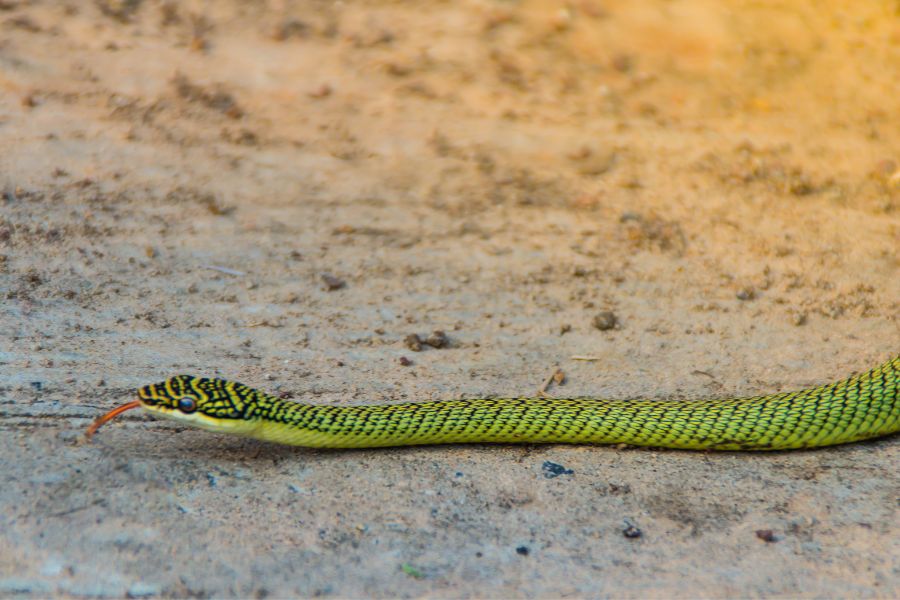
- Size: on average, they range between 11.5cm to 130 cm long.
- Where in Thailand they can be found: They can be found all over Thailand, but are more common in Southern Thailand. This is because they love living in coconut palms, and have often been found lurking in thatch roofing materials often used in homes in southern Thailand.
- Are they venomous? It’s mildly venomous since its fangs are located at the rear of its mouth, which means venom is only released when the snake chews its prey. Rear-fanged snakes are not considered dangerous to humans.
The Golden Tree Snake, also known as Chrysopelea Ornata Ornatissima, is a common snake found throughout Thailand and is known for its green coloration and unique behavior.
What makes the Golden Tree Snake unique is it’s capable of a type of flying, which is better described as throwing itself and falling. This allows it to move from tree to tree, mostly to catch prey.
They are excellent climbers, and are often seen slithering up coconut palms, resting on thin branches, or sliding up verticle rock faces.
They are also fast-moving snakes and can be seen and gone within a blink of an eye. They eat primarily rodents, as well as frogs, lizards and bats.
2. White-lipped Pit Viper
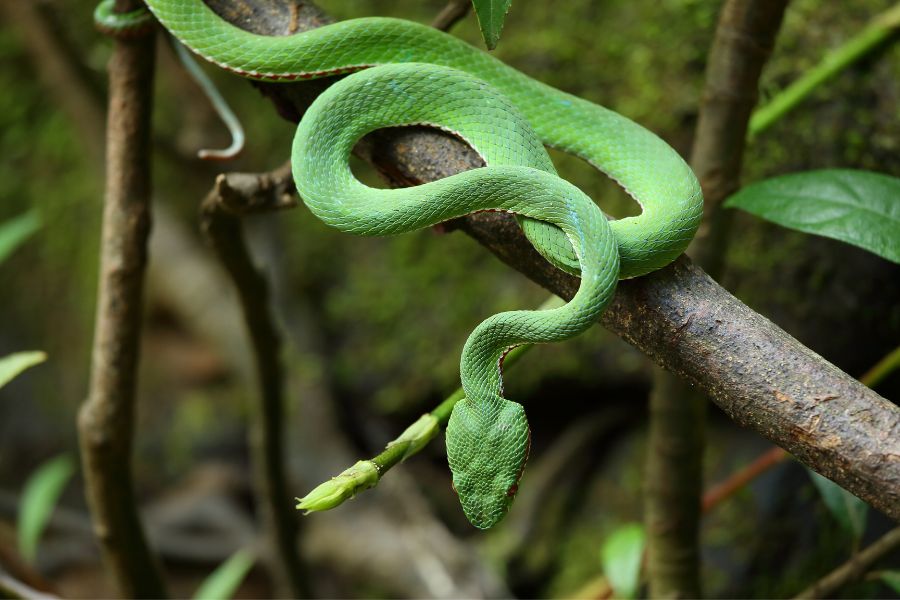
- Size: 60cm – 81cm
- Where in Thailand they can be found: They can be found throughout Thailand but usually areas with vegetation as opposed to human areas. They are nocturnal, solitary animals that like to live in cooler areas as they are heat sensitive.
- Are they venomous? Yes, they are highly venomous and their bites are considered hemotoxic. Of the bites reported, only a few have resulted in death.
The white-lipped viper, also known as a green tree pit viper or white-lipped bamboo pit viper, is a snake that’s widespread in Thailand and can be found in shrublands, agricultural areas, forests, and suburban areas.
They are identifiable by their bright green bodies and yellow eyes. The belly is often white or yellowish green.
They eat birds, small mammals and frogs, and hunts its prey by striking them and holding them until they die.
3. Radiated Rat Snake (Copperheaded Racer)
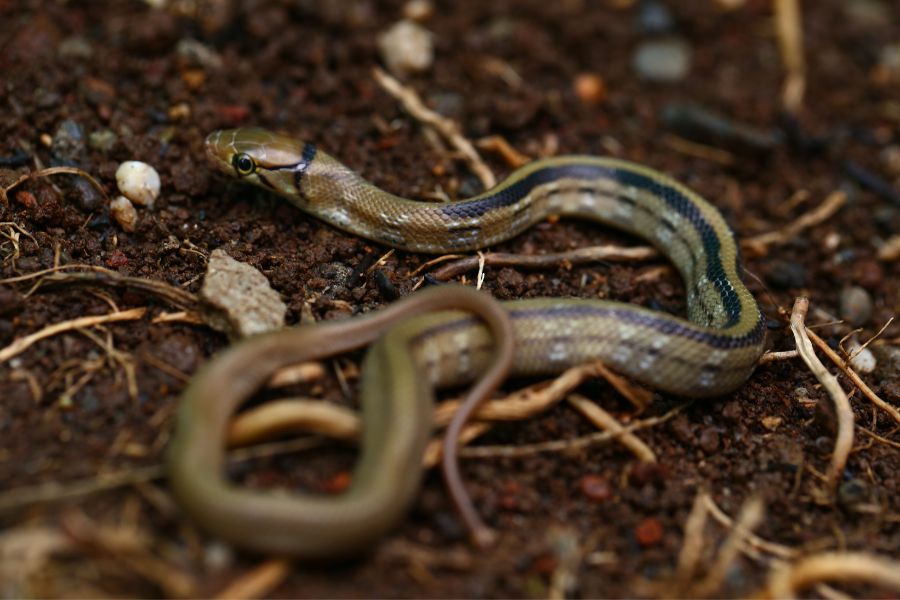
- Size: 150 cm – 210 cm on average
- Where in Thailand they can be found: They can be found all over Thailand but have been more frequently spotted on the islands, such as Phuket and Koh Phangan.
- Are they venomous? No, they are not venemous.
The Radiated Rat Snake, or Coelognathus radiata, also known as the Copper-headed Racer, is quite a common snake in Thailand.
They are characterized by their brown back with 4 black stripes, which breaks into streaks on the neck. The stripes are the most notable distinguishing feature on the snake.
It’s an aggressive snake that usually goes into defence mode, whereas most snakes won’t harm you unless provoked. Though fortunately, they are not venomous. When they are about to strike, they inflates the neck and show off their bluish underbelly, then bend their body and open their mouth wide.
They are fast-moving snakes, who prefer to live in open, dry, rocky environments, as well as in grassland and shrubland. They are rarely seen in the mountains or in the dense interior of a forest.
4. Monocled Cobra
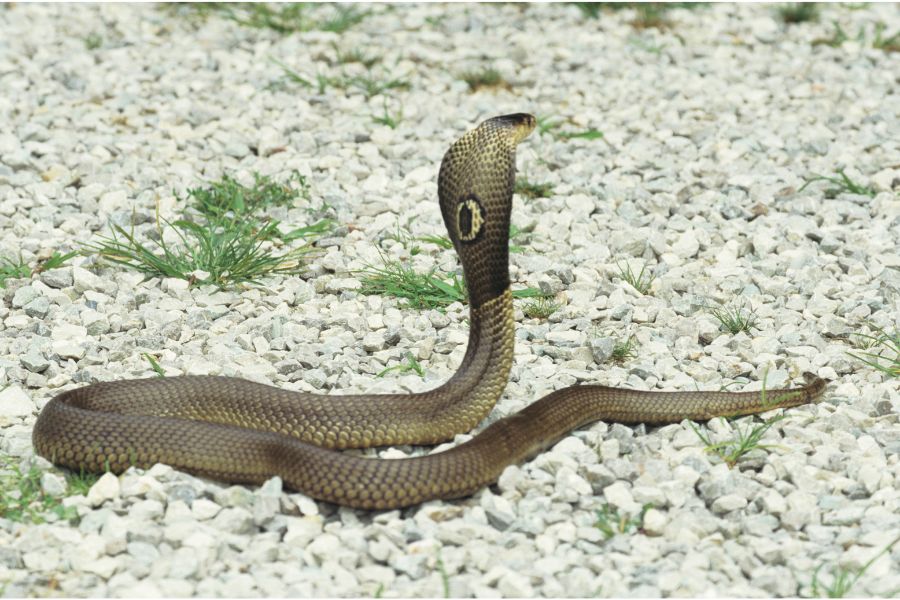
- Size: 135cm – 230cm
- Where in Thailand they can be found: They can be found all over Thailand but prefer habitats near water such as mangroves, swamps and rice paddies. They live in grassland and shrubs, as well as agricultural land.
- Are they venomous? Yes, they are highly venomous and hold the record for the highest fatality rate in Thailand.
One of the most poisonous snakes in Thailand, the Monocled Cobra is known for its distinctive hood in an O-shaped pattern on the back of the hood, and can be found in various habitats.
They may be yellow, brown, grey or blackish in color and have a cross-band pattern on their bodies. They also have large anterior fangs which contain potent venom.
They are very terrestrial animals and are mostly active at dusk. They hide in burrows and eat mostly frogs and small mammals such as other snakes and fish.
They usually prefer to escape when disturbed, but when threatened they will raise their bodies, spread their hood and hiss loudly.
A bite from a Monocled Cobra can be deadly. Early symptoms of a bite include drowsiness, flushing of the face, warm skin and pain around the bite. These symptoms may manifest to paralysis and death if not treated immediately.
Read more: Are There Crocodiles In Thailand? Yes, And They’re Under Threat
5. Malayan Pit Viper
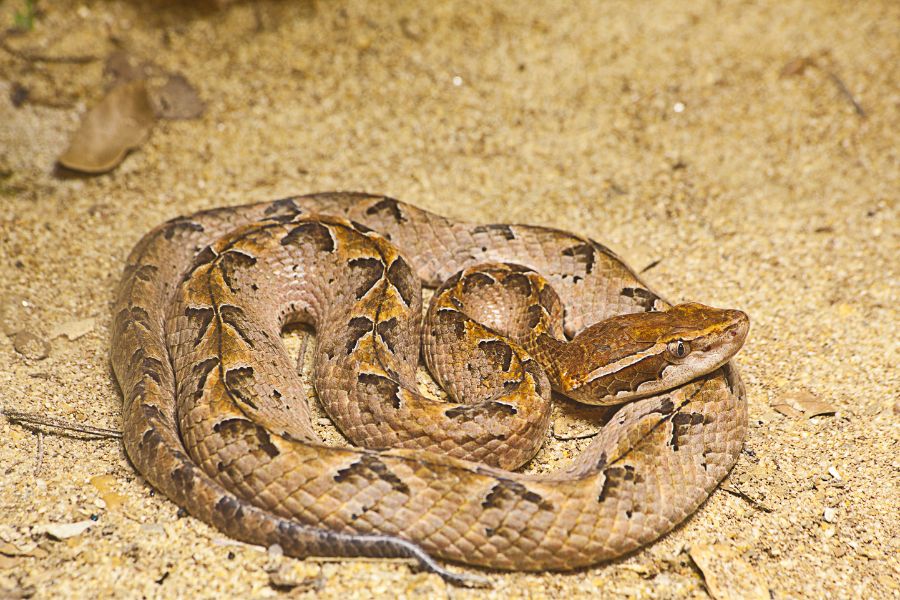
- Size: 70cm – 91 cm on average.
- Where in Thailand they can be found: They are found all over Thailand but prefers coastal forests, overgrown farmland, orchards and bamboo thickets.
- Are they venomous? Yes, they are highly venomous but deaths are rare.
This venomous snake is found in Thailand and is known for its triangular-shaped head and distinct reddish coloration. Their most identifiable characteristic is the two large, dark brown triangular blotches that line its body.
They are known to be bad-tempered snakes and are quick to strike. However, they are also quite sedentary animals and are known to sit in the same spot for several hours.
Their venom is highly poisonous, and can cause severe pain and swelling around the bite. In some cases, the venom can lead to tissue decay, but it’s rate to die from a Malayan Pit Viper bite.
However, many who have been bitten by this snake and not received fast treatment and antivenom have been left with dysfunctional limbs and even amputation.
The antivenom for this snake is manufactured in Thailand.
6. Red-Necked Keelback
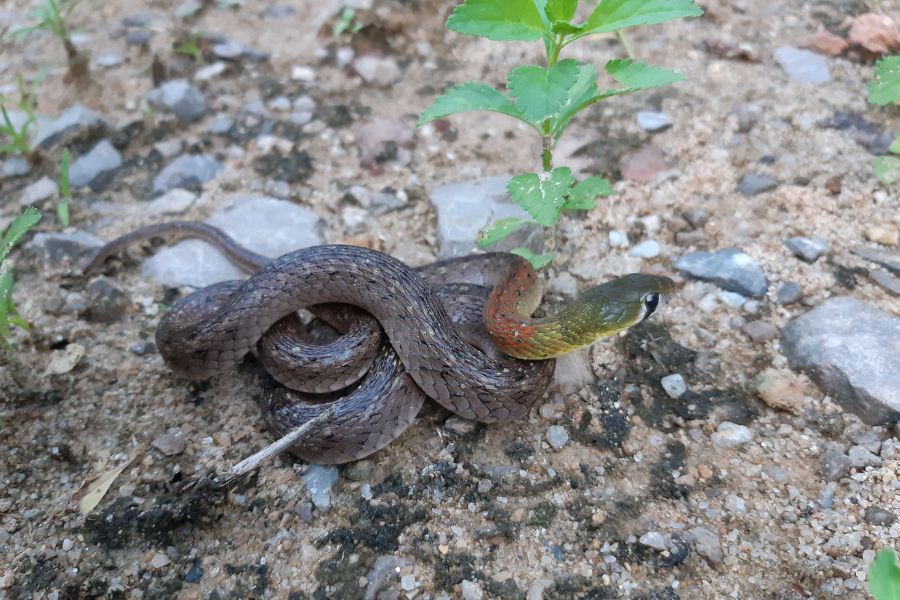
- Size: 70cm – 90cm
- Where in Thailand they can be found: They are usually found near lakes and ponds as they feed on frogs and small fish.
- Are they venomous? Yes, and they are classed as a highly deadly snake.
Another venomous snake found in Thailand, the Red-Necked Keelback is known for its red or orange neck coloration.
Since their fangs are located at the rear of their mouth, they were thought to not be threat to humans, until one fatal and several near-fatal attacks caused researchers to investigate.
They found that the snake attacks by biting and holding onto its prey, or repeatedly biting. However, they also found it has two upper jaw glands which produces an extremely venomous poison. The poison works by flowing into the bite at the back from the glands at the top.
The venom can cause internal hemorrhaging, as well as nausea, coagulopathy (when blood won’t clot), and even disseminated intravascular coagulation (when blood clots and blocks vessels in the body).
This species is listed on the schedule of the 1876 Dangerous Wild Animals Act.
7. Malayan Banded Krait
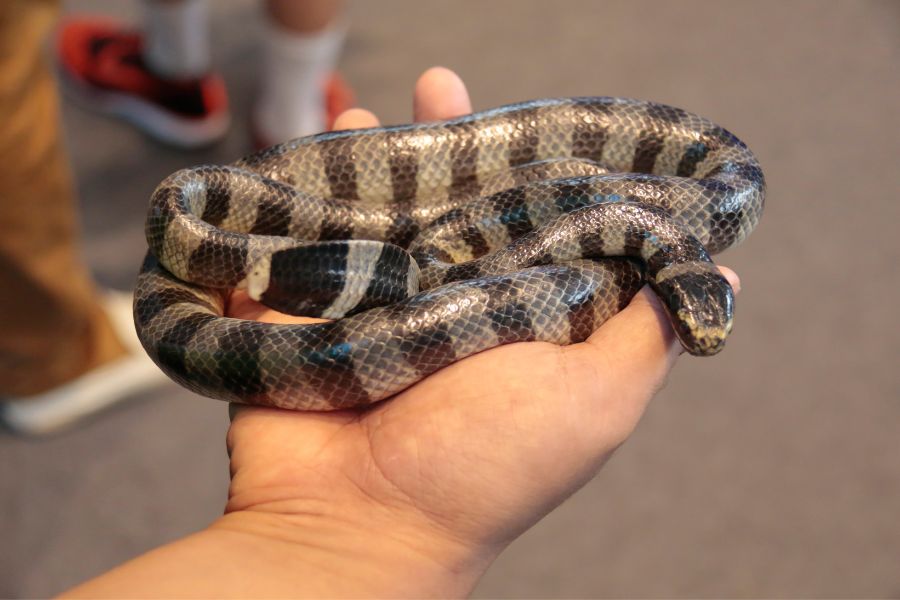
- Size: 180cm – 225cm
- Where in Thailand they can be found: They can be found all over Thailand but are usually spotted near forests and agricultural lands since they eat small rodents. They often lurk in termite mounds and rodent holes, and can sometimes come into human villages because they have a supply of rodents and water.
- Are they venomous? Yes, but bites are rare.
This highly venomous snake is black with distinct white bands and can be found in Thailand.
They are considered a timid snake with a docile nature, though it contains a venom that’s highly toxic to humans. They are mostly nocturnal and are considered more dangerous at night when they are in hunting mode. However, when disturbed they prefer to hide and generally don’t attempt to bite.
The most common effects of a bite are vomiting, abdominal pain, diarrhoea, and dizziness. Most severe symptoms include respiratory failure and death. If untreated, the morality rate is 1–10%.
There is only currently a polyvalent antivenom available in India and Indonesia.
8. Indo-Chinese Spitting Cobra
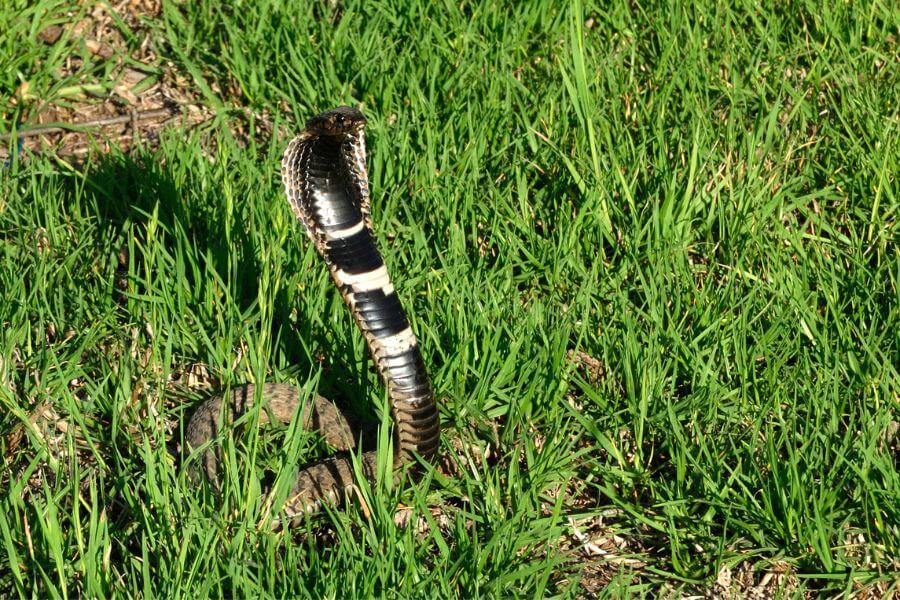
- Size: 90cm – 160 cm on average
- Where in Thailand they can be found: They are found all over the country but tend to stay in jungle habitats. They sometimes make their way into small villages due to the rodent population there.
- Are they venomous? Yes, and the venom is lethal. Death has only known to occur in rural areas where antivenom treatment wasn’t administered. If the venom gets into the eyes, it can cause permanent blindness.
The Indo-chinese Spitting Cobra, also known as the Thai Spitting Cobra or Saimese Spitting Cobra, is a venomous snake that prefers to live in lowlands, hills, plains, and woodland.
They are characterized by their brown/black bodies with white spots or stripes. The white pattern covers the entire snake. They also have a hood behind the head, and so are often confused with the monocled cobra.
What sets this snake apart from the others is that it’s a spitter, and readily spits its venom at its prey in a mist, rather than a stream. It’s estimated they can spit venom up to 1-2 meters away.
They are nocturnal animals, and are more aggressive at night. When threatened during the day, they are generally timid and will seek refuge in the nearest burrow, but at night they are known to stand their grounds and spit venom.
Striking and biting is a last resort. If they do bite, they are known to hold onto their prey and chew savagely. They eat rodents, frogs, and other snakes.
9. Burmese Python

- Size: up to 5 meters.
- Where in Thailand they can be found: They can be found all over Thailand but tend to live in jungle areas near a water source.
- Are they venomous? No, they are not venomous.
This is one of the largest snakes in Thailand, or the world for that matter, and is listed as vulnerable on the IUCN Red List. They are distinguished by their brown blotches that cover its back.
They are excellent swimmers and need to live near a permanent source of water. They tend to stay around grasslands, marshes, swamps, mangroves, river valleys and jungles with open clearings. They can stay in water for 30 minutes, but usually live on land.
They are also excellent climbers, though prefer to stay on the ground. They are nocturnal animals and spend much of their time hiding in underbrush.
They eat birds, frogs, small mammals and reptiles. They attack their prey by sitting and waiting, and then after striking, constrict their prey to suffocate it. Then they eat the prey whole.
10. Laotian Wolf Snake
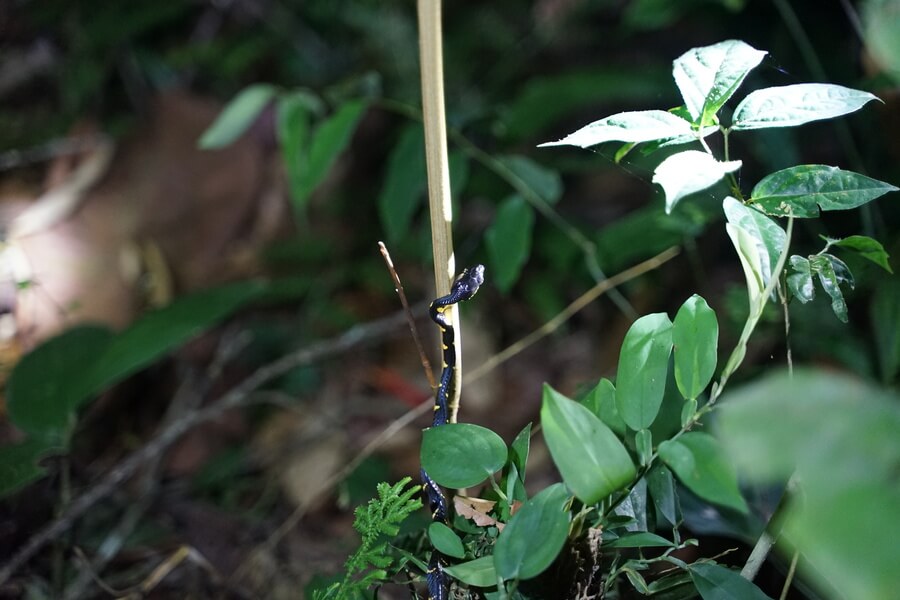
- Size: 10cm – 50cm
- Where in Thailand they can be found: They are found in jungle areas, such as Khao Sok National Park
- Are they venomous? No, they are not venomous.
Laotian Wolf Snakes are a non-venomous snake best known for their dark brown bodies with a whitish or yellowish crossband.
They are small snakes, rarely exceeding 50cm in length, and are nocturnal. They tend to live on the ground and are not considered dangerous or aggressive.
However, they are often mistaken for the aggressive banded krait.
11. Oriental Whip Snake
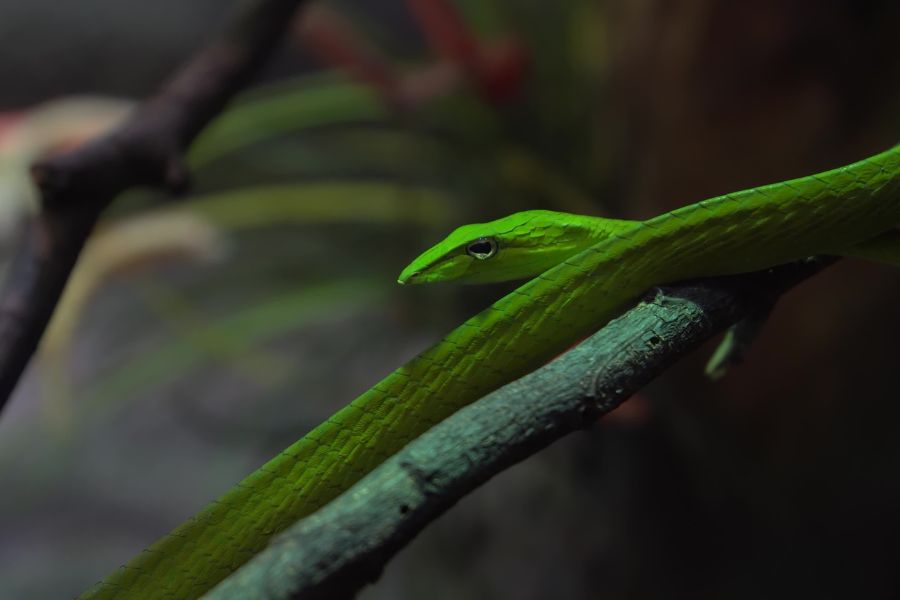
- Size: up to 180cm long
- Where in Thailand they can be found: They can be found all over Thailand, even in parks and urban areas, but prefer to live in trees as opposed to on the ground.
- Are they venomous? Yes, though they are rear-fanged and not considered a threat to humans.
The Oriental Whip Snake, also known as the Asian vine snake, is a mildly venomous snake that’s known for its bright, fluorescent green color and long, pointy head.
It’s a rear fanged snake, which means that it needs to bite and hold onto its prey in order for venom to be released. Therefore it’s not considered dangerous to humans.
They eat small reptiles and amphibians, and are shy and docile in nature. They prefer to stay away from humans and live in wooded areas and suburban parks and gardens. They prefer to live in trees and bushes.
12. Checkered Keelback
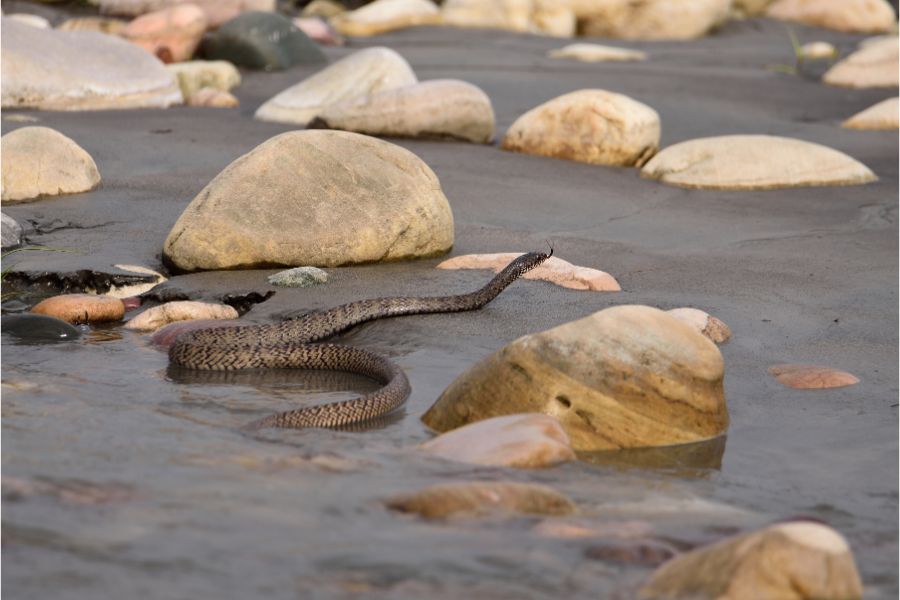
- Size: up to 175 cm
- Where in Thailand they can be found: They live all over Thailand but prefer to live near near freshwater lakes or rivers.
- Are they venomous? No, it’s not venomous.
The checkered keelback snake is another common snake in Thailand. It’s a medium-sized snake, and is considered harmless to humans.
They are semi-aquatic and eat small fish and water frogs. They are active by both day and night, and hunt on the edge of water bodies.
Although not a threat to humans, they are known to be alert and aggressive when hunting, and will try to escape in a jumpy fashion.
If it feels threatened, it will inflate its neck and raise its head. If it plans to strike, it will do so very fast.
FAQs About Snakes in Thailand
Are snakes a problem in Thailand?
It’s not uncommon for snakes to come into contact with humans, especially those living in rural areas and villages. While you may see a snake, attacks are rare.
How likely am I to see a snake in Thailand?
It’s estimated that only 2% of tourists will see a snake in Thailand, and those snakes tend to be in the wild rather than urban areas.
Where is the best place to see a snake in Thailand?
The best place to go if you want to see snakes in the wild is Khao Sok National Park. If you take one of the popular night safaris, you may see some snakes waking up for their night time hunt. Though sightings are still rare.
Final Thoughts
While snakes can be scary, it’s important to note that as a tourist you are very unlikely to see one unless you go looking for them, and even then, it’s not always guaranteed.
On the whole, snakes don’t pose a threat to tourists, though they are still dangerous animals in Thailand and shouldn’t be approached if you do see one.
We hope you found this guide helpful and insightful.

Thanks for this website, I found a snake in my yard and was curious if it was venomous. It is, so I will not be out there looking at him anymore! I’m new to Thailand, again, thanks!
Hi William, I’m glad you found this guide helpful and was able to identify the snake in your garden! Hope he slithers away and finds a home elsewhere.
I wish I could post a picture. On a morning walk in NE Thailand where we lived we came upon a black and yellow banded Krait. I read about them and even when we saw it (it was dead) I had a bad feeling. No anti venom for this bite you just are done????????
Hi Jay, thank you for sharing your experience with your encounter of a snake in Thailand!
Hi,
We were riding on an abandoned road, only used by workers, we are Dutch tourists and took a wrong turn.
There on the road a very green snake 1 meter long was coming at us very fast. We were in a car thank god:) but what leave green snakes in Thailand are fast?
It could have been a Whip Snake, but without a picture it’s hard to tell. I’ve seen a lot of these snakes on the roads in Thailand and other countries in Southeast Asia, especially central Laos, and they usually come out at dusk and move very fast across the roads.
i surprise that a green snake i saw in my room and i dont have any idea where it was comming from as my room is in 3rd floor and i live in city,